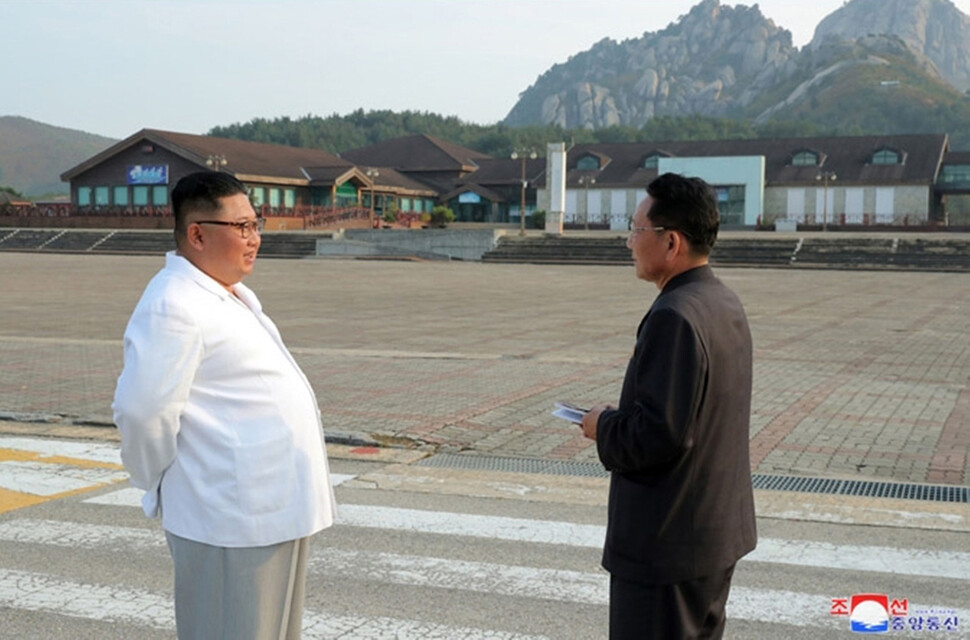hankyoreh
Links to other country sites 다른 나라 사이트 링크
[Editorial] N. Korea should immediately rescind decision to demolish Mt. Kumgang structures

North Korean leader Kim Jong-un ordered the demolition of South Korean structures at Mt. Kumgang, according to reports by North Korean news outlets on Oct. 23. While we will have to wait to find out the reasons behind Kim’s orders, they appear at first glance to be an expression of discontentment over the failure to resume tourism at the complex as agreed upon with South Korea last year. It’s deeply concerning to think how far the ramifications of this unexpected demolition order might reach.
Tourist facilities at Mt. Kumgang have long served as a symbol of inter-Korean cooperation. Pyongyang has sent numerous messages to Seoul urging its resumption to no avail, and now it appears to have made the extreme decision to tear the structures down. But no matter how difficult the situation might be, it is of no help to the advancement of inter-Korean relations to unilaterally announce the Mt. Kumgang facilities’ demolition. We hope North Korea immediately rescinds its decision.
Kim used harsh rhetoric when issuing his Mt. Kumgang demolition order, calling the buildings “shabby South Korean structures” and saying “it makes me unhappy even to look at them.” His remarks are proof of his disgruntlement and disappointment toward the South – but the excessive tone and his seeming inability to conceal his emotions will only worsen public opinion in the South and leave inter-Korean relations in an even deeper bind.
Kim’s order is also significant in running completely counter to a decision by his predecessors. Tourism at Mt. Kumgang has been seen as a premier example of inter-Korean economic cooperation, rooted in a decision by his father and former North Korean leader Kim Jong-il. Kim Jong-un described the project as “the mistaken policy of the predecessors who tried to get benefits without any effort after just offering [up] the tourist area.” He also said that it was “not desirable to let the south side undertake the tour [business at] Mt. Kumgang.” This indicates his intent for North Korea to go it alone with Mt. Kumgang in the future, but it could also be a signal that other projects spearheaded by his father Kim Jong-il could be rolled back. It’s even more worrying to consider the potential future impact this shift in attitudes could have on the Kaesong Industrial Complex.
At the same time, Kim accompanied his order for the structures’ demolition with the proviso that it would “based on discussions with the relevant South Korean sector.” The suggestion that he does not plan to proceed unilaterally with the demolition could be a stroke of good fortune. It could be interpreted as Kim using the threat of demolition as a pretext for opening up a window for discussions with Seoul. With Pyongyang stating its willingness to hold discussions, the South Korean government now needs to actively consider bucking current trends and looking upon these discussions as an opportunity to find a way forward toward resuming the tourism effort.
North Korea’s aggressive move with its threat of tearing down the Mt. Kumgang facilities could also be seen as an indirect means of applying pressure on the US, which has been responsible for preventing tourism from resuming. In effect, it may be using the Mt. Kumgang tourism effort as a way of pressing Seoul to play a more active “facilitator” role with Washington. That reading is bolstered by the fact that Kim was accompanied on his inspection by First Vice Foreign Minister Choe Son-hui, who is responsible for denuclearization negotiations with the US. Seoul needs to analyze Pyongyang’s intentions closely and respond in an effective way. We look forward to seeing a wise alternative approach that can halt this spiral and turn things in a more favorable direction.
Please direct comments or questions to [english@hani.co.kr]

Editorial・opinion
![[Editorial] Yoon must halt procurement of SM-3 interceptor missiles [Editorial] Yoon must halt procurement of SM-3 interceptor missiles](https://flexible.img.hani.co.kr/flexible/normal/500/300/imgdb/child/2024/0501/17145495551605_1717145495195344.jpg) [Editorial] Yoon must halt procurement of SM-3 interceptor missiles
[Editorial] Yoon must halt procurement of SM-3 interceptor missiles![[Guest essay] Maybe Korea’s rapid population decline is an opportunity, not a crisis [Guest essay] Maybe Korea’s rapid population decline is an opportunity, not a crisis](https://flexible.img.hani.co.kr/flexible/normal/500/300/imgdb/original/2024/0430/9417144634983596.jpg) [Guest essay] Maybe Korea’s rapid population decline is an opportunity, not a crisis
[Guest essay] Maybe Korea’s rapid population decline is an opportunity, not a crisis- [Column] Can Yoon steer diplomacy with Russia, China back on track?
- [Column] Season 2 of special prosecutor probe may be coming to Korea soon
- [Column] Park Geun-hye déjà vu in Yoon Suk-yeol
- [Editorial] New weight of N. Korea’s nuclear threats makes dialogue all the more urgent
- [Guest essay] The real reason Korea’s new right wants to dub Rhee a founding father
- [Column] ‘Choson’: Is it time we start referring to N. Korea in its own terms?
- [Editorial] Japan’s rewriting of history with Korea has gone too far
- [Column] The president’s questionable capacity for dialogue
Most viewed articles
- 1Months and months of overdue wages are pushing migrant workers in Korea into debt
- 2At heart of West’s handwringing over Chinese ‘overcapacity,’ a battle to lead key future industries
- 3[Editorial] Yoon must halt procurement of SM-3 interceptor missiles
- 4Trump asks why US would defend Korea, hints at hiking Seoul’s defense cost burden
- 5Under conservative chief, Korea’s TRC brands teenage wartime massacre victims as traitors
- 6Fruitless Yoon-Lee summit inflames partisan tensions in Korea
- 7[Guest essay] Maybe Korea’s rapid population decline is an opportunity, not a crisis
- 8[Column] For K-pop idols, is all love forbidden love?
- 9[Editorial] 10 years on, lessons of Sewol tragedy must never be forgotten
- 10[Editorial] When the choice is kids or career, Korea will never overcome birth rate woes